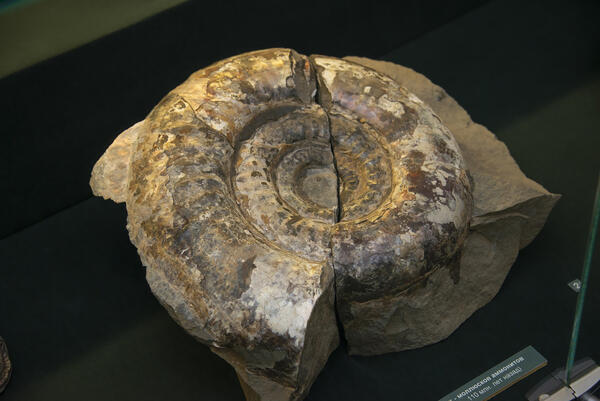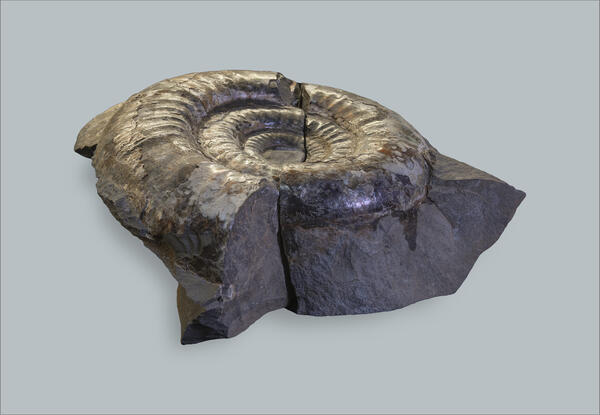Ammonites inhabited the planet from the Devonian and disappeared during the Cretaceous– Paleogene extinction event.
They lived in warm seas with a certain salinity degree, which once covered the area of the present-day Taimyr lowland, and, like other stenohaline animals, never entered river mouths and freshwater bodies.
The shells of the first cephalopods were right cone-shaped, which reduced their mobility and made the mollusks easy prey. Gradually, the shell’s shape changed and evolved into a compact and maneuverable spiral. By occupying the front of this shell, the mollusk built up its edges while creating septae and internal compartments. A siphon tube with blood vessels passed through several septae. Using it, the mollusk could fill the compartments with water or carbon dioxide and thus change its buoyancy.
Judging by the variety of shells — from discoidal to almost spherical — ammonites lived at different depths and differed in their speed of movement and their ecological niches. Driven ashore, they fell prey to small dinosaurs, while in the water they were hunters themselves.
Heteromorphic species with unfolded, twisted, hooked, or straight shells occurred among ammonites, but generally, the spiral shells prevailed. The mollusks were named after the spiral horns of the ancient Egyptian deity Amon.
Ammonites are of great importance to geologic research. They belong to the so-called index fossils, which belong strictly to a certain geological period, and their presence in the geological record allows to accurately determine the age of the rock. Ammonite deposits are particularly useful in distinguishing between the Jurassic and the Cretaceous systems.
This ammonite was found in the headwaters of the Volochanka River in 1994–1996. It was handed over to the Museum of Regional Studies by Vadim Nikolaevich Sedov, geologist of the Avamskaya Party of the Norilsk Complex Geological Exploration Expedition. The find is about 145–151 million years old. The prismatic layer of the shell is white to brownish-yellow in color with a partially preserved mother-of-pearl layer; the inner parts are filled with greenish-gray rock.
In many cultures around the world, the ammonite shell symbolizes prosperity and well-being, and family harmony, and is considered a sign of infinity, foresight, and a sense of connection between times.
They lived in warm seas with a certain salinity degree, which once covered the area of the present-day Taimyr lowland, and, like other stenohaline animals, never entered river mouths and freshwater bodies.
The shells of the first cephalopods were right cone-shaped, which reduced their mobility and made the mollusks easy prey. Gradually, the shell’s shape changed and evolved into a compact and maneuverable spiral. By occupying the front of this shell, the mollusk built up its edges while creating septae and internal compartments. A siphon tube with blood vessels passed through several septae. Using it, the mollusk could fill the compartments with water or carbon dioxide and thus change its buoyancy.
Judging by the variety of shells — from discoidal to almost spherical — ammonites lived at different depths and differed in their speed of movement and their ecological niches. Driven ashore, they fell prey to small dinosaurs, while in the water they were hunters themselves.
Heteromorphic species with unfolded, twisted, hooked, or straight shells occurred among ammonites, but generally, the spiral shells prevailed. The mollusks were named after the spiral horns of the ancient Egyptian deity Amon.
Ammonites are of great importance to geologic research. They belong to the so-called index fossils, which belong strictly to a certain geological period, and their presence in the geological record allows to accurately determine the age of the rock. Ammonite deposits are particularly useful in distinguishing between the Jurassic and the Cretaceous systems.
This ammonite was found in the headwaters of the Volochanka River in 1994–1996. It was handed over to the Museum of Regional Studies by Vadim Nikolaevich Sedov, geologist of the Avamskaya Party of the Norilsk Complex Geological Exploration Expedition. The find is about 145–151 million years old. The prismatic layer of the shell is white to brownish-yellow in color with a partially preserved mother-of-pearl layer; the inner parts are filled with greenish-gray rock.
In many cultures around the world, the ammonite shell symbolizes prosperity and well-being, and family harmony, and is considered a sign of infinity, foresight, and a sense of connection between times.





